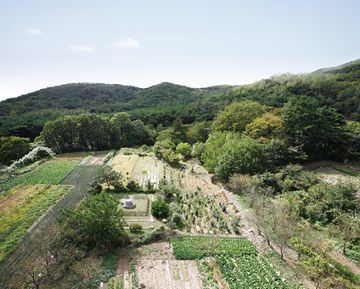포항 법광사지
| 포항 법광사지 Beopgwangsa Temple Site, Pohang |
|
 포항 법광사지, 국가문화유산포털, 문화재청. |
|
| 대표명칭 | 포항 법광사지 |
|---|---|
| 영문명칭 | Beopgwangsa Temple Site, Pohang |
| 한자 | 浦項 法光寺址 |
| 주소 | 경상북도 포항시 북구 신광면 상읍리 967번지 일원 |
| 지정번호 | 사적 제493호 |
| 지정일 | 2008년 1월 30일 |
| 분류 | 유적건조물/종교신앙/불교/사찰 |
| 시대 | 통일신라 |
| 수량/면적 | 24,840㎡ |
| 웹사이트 | 포항 법광사지, 국가문화유산포털, 문화재청. |
|
|
|
해설문
국문
포항 법광사지는 기록에 따르면 신라 진평왕(579~632) 때 원효대사가 왕명으로 창건하였고, 흥덕왕 3년(828) 7월에 탑을 세웠다고 한다. 문성왕 8년(846) 9월에 탑을 옮겨 짓고 사리 22과를 봉안하였다. 당시 법광사 규모는 525칸으로 불국사와 맞먹는 규모와 수준의 신라 대가람*이었다. 조선 영조 22∼23년(1746∼1747)에 석탑, 2층 금당, 5칸 대웅전만 남을 정도로 대가람의 형편이 기울어졌다. 포항 법광사는 철종 14년(1863)에 불에 타 없어진 뒤 몇몇 건물을 다시 지었으나 또 다시 화재를 입어 폐사*하였다.
현재 모든 건물은 불에 타 없어진 채 절터만 남았다. 삼층 석탑, 금당지(녹유전과 연화석불대좌 등), 당간지주, 쌍신두귀부 그리고 각종 건축용 석물 등이 논과 밭에 남아 있다.
2010년∼2017년에 걸쳐 실시한 발굴 조사에서 삼국시대부터 조선시대에 이르는 많은 건물지, 석축, 담장, 계단, 연지 등을 확인하였지만 건물과 시설들은 여러 시기에 걸쳐 반복하여 세워져 정확한 시기별 규모와 배치 양상은 명확하지 않다. 이곳에서 출토된 다양한 건축용 석부재와 여러 종류의 기와 등은 신라 왕경의 건물에 버금가는 품격과 위상을 갖고 있다.
- 대가람: 가치가 높거나 규모가 큰 절.
- 폐사: 폐하여져 승려가 없는 절
영문
Beopgwangsa Temple Site, Pohang
This is the former site of Beopgwangsa Temple. The temple is presumed to have been originally built around the 7th century and existed until the 19th century. According to records, at its zenith is was a large Buddhist temple comparable in size and status to Bulguksa Temple in Gyeongju. In 828, a pagoda containing the remains of Sakyamuni Buddha was built on the site. However, by the middle of the 18th century, Beopgwangsa had significantly decreased in size, with only one stone pagoda, a Daeungjeon Hall, and one other Buddhist hall remaining. In 1863, the temple burnt down and was partially reconstructed, but it burnt down again a few years later in another fire.
Currently, most of the site is covered by rice paddies and fields. However, traces of the temple remain, including a three-story stone pagoda, stone flagpole supports, a pedestal for a Buddhist statue, a stele which records the repair of the pagoda, and various stones used in the construction of the buildings. A stone pedestal in the shape of two tortoises, which originally supported the body of a stele, also remains. This unusual stele pedestal design can be found only at temple sites in Gyeongsangbuk-do.
Through excavation surveys conducted from 2010 to 2017, the remains of various buildings, stone foundations, old walls, staircases, and lotus ponds, dating from the Three Kingdoms period (1st century CE-7th century CE) to the Joseon period (1392-1910), were discovered. Shards of various roof tiles were also excavated.
Next to the former temple site stands a new Beopgwangsa Temple complex, built in the middle of 20th century.
영문 해설 내용
이곳은 법광사의 옛터이다. 법광사는 7세기경에 창건되어 19세기까지 유지되었던 것으로 추정된다. 기록에 따르면, 이 사찰은 원래 경주 불국사와 맞먹는 규모와 수준의 대가람이었다고 하며, 828년에 석가모니불의 사리를 모신 탑을 세웠다고 한다. 그러나 18세기 중반경에는 대웅전, 석탑 1기, 전각 1동만 남았을 정도로 형편이 많이 기울어졌다. 1863년에 불에 타 없어진 뒤 일부 건물을 다시 지었으나, 몇 년 후 다시 화재가 일어나 소실되었다.
현재 절터는 대부분 논과 밭이 되었고, 삼층석탑, 당간지주, 불상대좌, 탑의 중수 사실을 기록한 비, 각종 건축용 석재 등이 남아 있다. 그리고 비석의 대좌가 하나 있는데, 두 마리의 거북이 비석의 몸돌을 받치는 독특한 형태로, 이러한 형태는 경상북도 지역의 절터에서만 발견되었다. 2010년부터 2017년까지 실시된 발굴조사 결과, 삼국시대부터 조선시대에 이르는 여러 건물지, 석축, 담장, 계단, 연지 등이 확인되었고, 다양한 종류의 기와가 출토되었다.
절터 바로 옆에 있는 법광사는 20세기 중반에 새로 지어졌다.